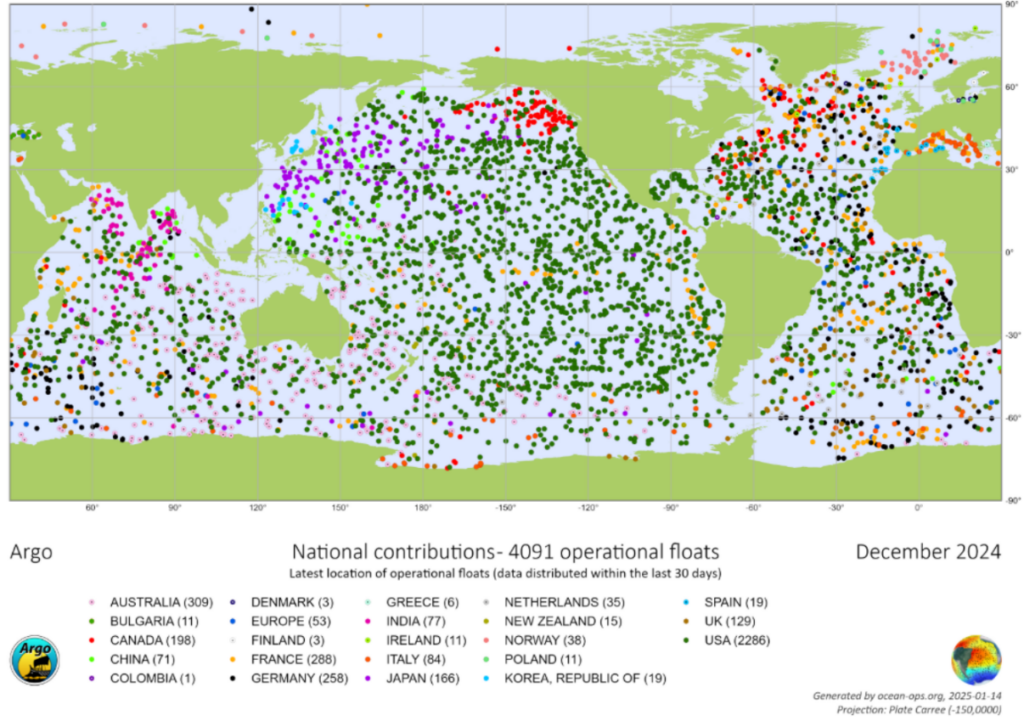Argo, the global network of autonomous floats that revolutionized ocean observation, marked its 25th anniversary in December. This milestone celebrates not only Argo’s transformative contributions to ocean science but also its vital role as part of the Global Ocean Observing System (GOOS).

Since its inception in 1999, Argo has grown into a fleet of nearly 4,000 robotic floats, drifting with ocean currents and conducting dives of up to 6,000 meters. These floats collect critical data that contribute to the Global Ocean Observing System (GOOS), allowing us to better understand changes in ocean heat, sea level rise, and circulation, improve weather and extreme event forecasts, and help society manage and adapt to environmental change.
Argo provides an excellent example of international collaboration, with 23 nations currently contributing floats and a data management system that delivers consistent quality-controlled data streams to the global data center. This data has been instrumental in answering numerous global questions, such as assessing the ocean heat content, which revealed that the upper 2,000 meters of the ocean have absorbed approximately 90% of the excess heat from anthropogenic warming over the past two decades—crucial information for understanding sea-level rise.
As one of 13 mature observing networks under GOOS, Argo complements long-standing systems like the Voluntary Observing Ships (VOS) network, which dates back over 150 years. It also serves as an example to new emerging networks, such as the Fishing Vessel Observing Network (FVON) or Surface Ocean CO2 Observing Network (SOCONET), which recently joined GOOS.
“Argo has grown from being the ‘new kid on the block’ to a mature and critical piece of our global ocean observing infrastructure, delivering real-time observations for ocean and weather prediction models every day throughout the year,” says Joanna Post, Director of the GOOS Management Team.

A recent press release by the National Oceanic and Atmospheric Administration (NOAA) highlights the remarkable evolution of Argo:
<…> The original Argo array consisted of core floats measuring temperature and salinity in the upper 1.2 miles (2,000 meters) of the ocean. In recent years, scientists and engineers have developed new capabilities and new types of floats that, together, make up a new full depth and multidisciplinary design called OneArgo, an ambitious expansion of Argo’s first design. In addition to Core floats, OneArgo includes biogeochemical and deep Argo floats.
Biogeochemical Argo floats include more sensors to measure ocean variables that are critical for understanding and addressing environmental issues, like low oxygen levels and ocean acidification.
”When biogeochemical Argo reaches global coverage, we will, for the first time, be able to monitor on a global scale in real time the pH of the ocean,” says Emily Osborne, a scientist with NOAA’s Atlantic Oceanographic and Meteorological Laboratory. Monitoring ocean pH is particularly important for tracking the health of many marine organisms.
Deep Argo floats extend the robots’ depth range to 3.7 miles (6,000 meters) below the ocean surface. The deep ocean is another place where the data scarcity is “outrageous,” says Susan Wijffels, a senior scientist with the Woods Hole Oceanographic Institution, who has worked with Argo since 1999. Deep Argo’s first mission will map the deep ocean in detail, allowing scientists to better understand what controls deep ocean flows and then to track changes there.
To boost the expansion and impact of these sentinels of the sea, the Argo Program received $2.7 million in funding in April 2024 to support the implementation of OneArgo. This funding will enhance observing capabilities in two key regions that are ecologically and economically important to the U.S.: the Gulf of Mexico and the California Current ecosystem. <…>
While OneArgo represents a bold vision for the future of ocean observing, achieving full implementation will still require a significant scaling up of resources—roughly four to five times the current investment. Bringing this vision to life will also depend on strong community support, advocacy, and continued collaboration across national and international partnerships. The progress made so far demonstrates what is possible with sustained commitment, and with the right support, OneArgo has the potential to become an impactful expansion of the global ocean observing system.
While OneArgo represents the future of global ocean observing, its foundation lies in the success of Argo over the past 25 years. As we celebrate this milestone, Argo’s legacy highlights the power of international collaboration through GOOS in transforming ocean observation and shaping a more sustainable future.
About GOOS:
The Global Ocean Observing System (GOOS) is the global home of ocean observing expertise. We lead and support a community of international, regional and national ocean observing programmes, governments, UN agencies, research organizations and individual scientists. Our Core Team of expert panels, networks, alliances and projects, supported by the GOOS Office, is in touch with ocean observing and forecasting around the world. We are a programme led by the Intergovernmental Oceanographic Commission (IOC) of UNESCO, with UN and science co-sponsors: World Meteorological Organization (WMO), UN Environmental Programme (UNEP) and the International Science Council (ISC).
